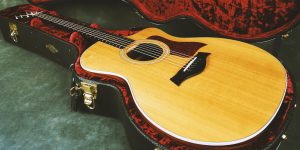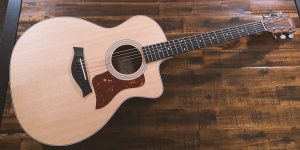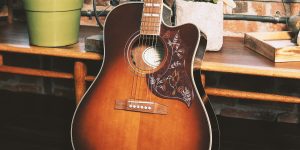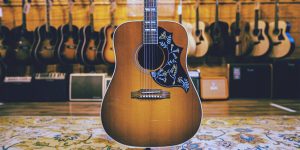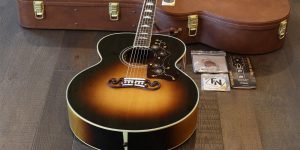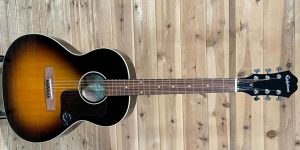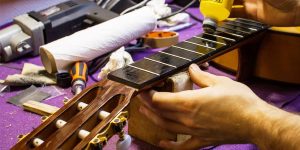I want to tell you about the three best Epiphone acoustic guitars. But first, a few words about this brand. The company House of Stathopoulos in New York started back in 1923 in the US and originally produced banjos. And already in 1924, the name Epiphone was registered as a trademark (shortened from the name of the creator of the Greek immigrant Epaminondas Stathopoulos), which until the 1950s, produced various stringed instruments which have gained a certain recognition. Since 1957, Epiphone has been a subsidiary of guitar manufacturer Gibson, so the legendary guitars from Gibson are now available in the lower and middle price range, maintaining the tradition and quality of production while using cheaper materials.
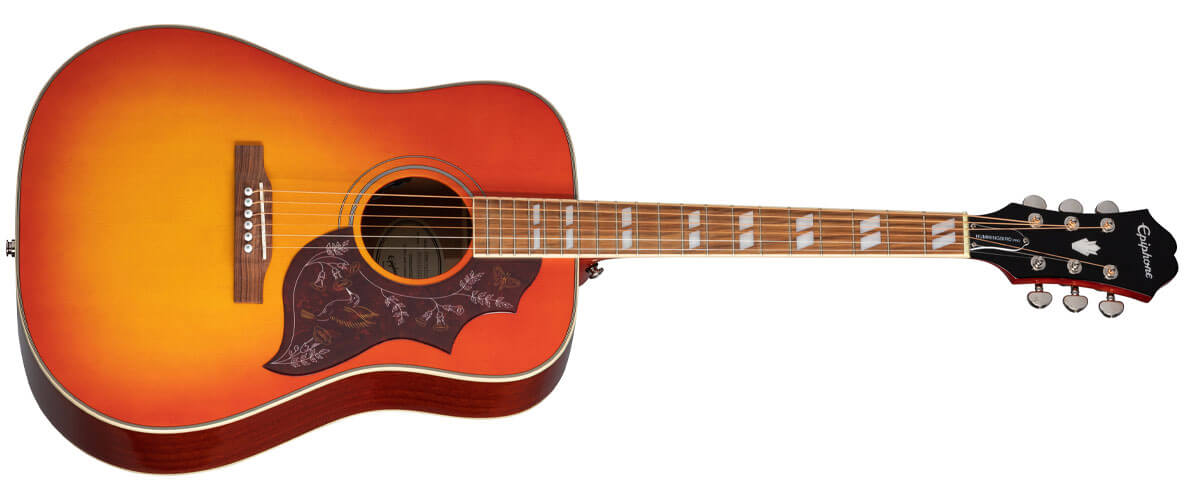
Epiphone electric guitar comparison table
| Guitar | Scale, in/cm | Fretboard radius, in/cm | Neck joint | Detailed review |
|---|---|---|---|---|
| Epiphone Hummingbird Studio best overall | 24.7/62.8 | 12/30.4 | glued-in | Review |
| Epiphone J-200 EC Studio | 25.5/64.7 | 12/30.4 | glued-in | Review |
| Epiphone DR-100 | 25.5/64.7 | 12/30.4 | glued-in | Review |
Is Epiphone a good brand?
Even though Epiphone is the budget line of Gibson guitars, you can tell right away that they are pretty good. It is the top entry-level segment, and the brand’s assortment brims with different models, which are licensed copies of Gibson models and even use their names. Sure, they are inferior to their original versions, but they are much cheaper.
In many Epiphone acoustic guitar reviews, you can find the names of the guitar world professionals who use this brand. Among them, you can find Tommy Thayer (Kiss), Tony Iommi, Jeff Waters (Annihilator), Noel Gallagher, B.B. King, Billie Joe Armstrong, and Joe Bonamassa. So agree that this is the strongest confirmation of my words.
Best Epiphone Acoustic guitar reviews
Epiphone Hummingbird Studio – best overall
I am glad to share with you the Epiphone Hummingbird Studio review. This acoustic-electric guitar deserves attention because its predecessor Epiphone Hummingbird Pro has long earned its popularity among tens of thousands of fans worldwide. Even earlier, in the 60s, the first Hummingbird guitar was introduced by Gibson, played in its time by Keith Richards, Dave Davis, and even the Beatles. And today, it's a beautiful budget-updated classic, a premium alternative for those who appreciate quality and sound.
Body

The guitar's body is made in the Dreadnought shape with a classic Hummingbird Pickguard. It has no cutaway, which makes it difficult to access the top frets. This guitar is large, with square shoulders, and its scale is 24.75 inches long. The top material is solid spruce, and the side and back are mahogany, which makes it durable and contributes to a great sound. The glossy surface finish will also keep your instrument looking good for a long time.
Neck, fingerboard, headstock
The elegant 12" radius Slim Taper D fingerboard is made of mahogany and is dovetailed to the body at the 14th fret. The Pau Ferro with Pearloid Twin Parallelogram inlays fingerboard has 20 Medium Jumbo frets. The fingerboard is very comfortable for my hands, and I think it should also be comfortable for small hands. The Grover Rotomatic 18:1 tuners look pretty sturdy and tune easily. All of this ensures that the guitar is singable and long-lasting.
Pickup system
What makes this excellent model modern is its electronics, thanks to which you can get an amplified acoustic sound, even on stage. The Epiphone Hummingbird Studio acoustic-electric guitar has a Fishman Sonicore under-saddle pickup system and a Fishman Sonitone preamp. Remember that when you play acoustics with electronics, you will lose out on the lower frequencies one way or another. But it is a necessity because otherwise, the guitar will boom.
Sound quality
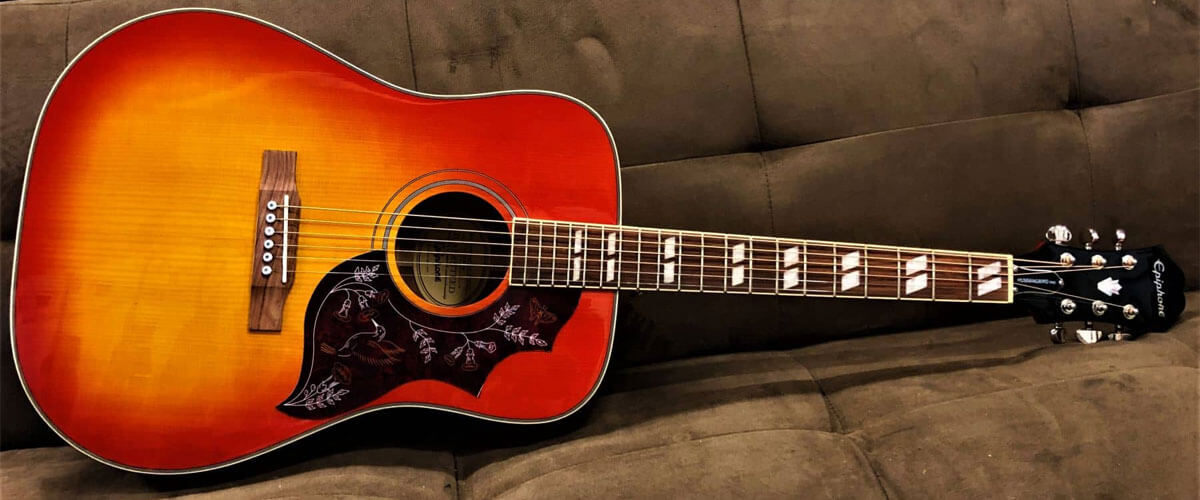
Thanks to its retro-style shape, build quality, and the features described above, Epiphone Hummingbird Studio can provide a loud, deep, spacious sound with good projection. A balanced, resonant sound will reach every corner of your room. Of course, you shouldn't expect it to be flawless. But considering the price, it completely satisfies all the objectives.
Key specs
- Scale, in/cm: 24.7/62.8.
- Frets: 20.
- Fretboard radius, in/cm: 12/30.4.
- Type: acoustic/electric.
- Body material: mahogany.
- Neck material: mahogany.
- Neck joint: glued-in.
The best Epiphone acoustic guitar is the Epiphone Hummingbird Studio, of course. A great budget-updated classic, a premium alternative for those who appreciate quality and sound. Thanks to its retro-style Dreadnought shape, build quality, and performance, it can provide a loud, deep, capacious sound with good projection.
Epiphone J-200 EC Studio
Today I will present to you the Epiphone J-200 EC Studio review. According to the manufacturer, this model pays tribute to the king of flattops - the classic Gibson SJ-200 model. The same huge frame in rich Sunburst color with an iconic Imitation Tortoise with Iconic J-200 Graphics Pickguard and a "mustached" bridge - it is considered one of the most important models of the Epiphone. Well, I suggest you take a closer look at the features of the Epiphone J-200 EC Studio, so you will be convinced of its not only external beauty.
Body
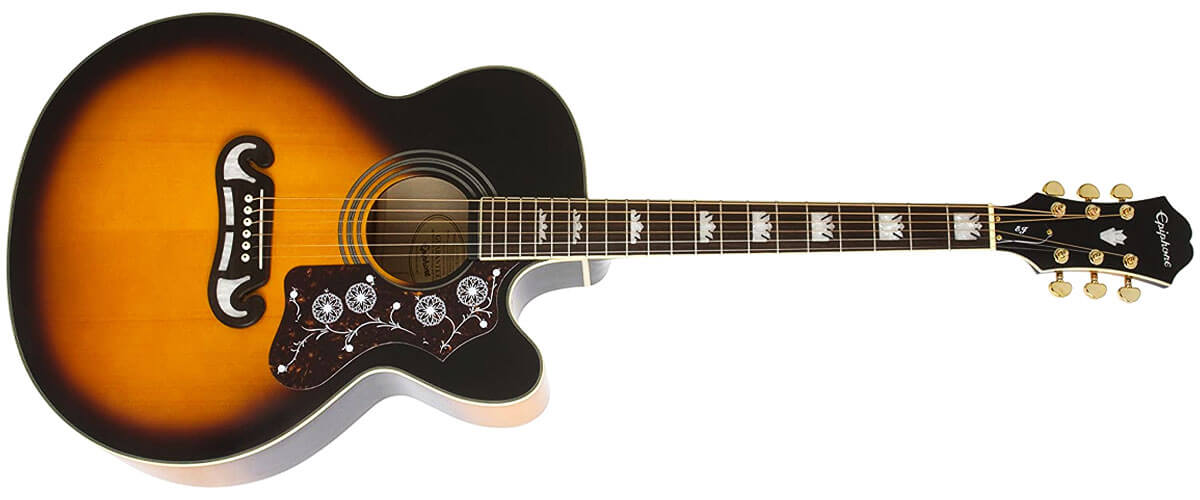
This guitar is made for lovers of everything huge because it is in the shape of a Super Jumbo. It's even bigger than a Dreadnought! And, of course, it sounds even louder. The back and sides in Select Maple and the top in Glossy Solid Spruce will ensure the instrument's longevity, and its sound will only improve over time. The cutaway provides complete access to all frets, regardless of the size of the guitar, and provides sonic projection and volume. Stability and balanced resonance are achieved thanks to the scalloped bracing system inside the body. The build quality is impressive, and although this model is representative of the mid-price segment, you will be proud of it.
Neck, fingerboard, headstock
A superb 1960s SlimTaper D-shape neck in Selected Maple with a 12" radius is glued to the guitar's body. The Pau Ferro fretboard has 20 Medium Jambo frets and is inlaid with Pearloid "Crown," and the scale is 25.5 inches long! By the way, the Pau Ferro material was a worthy substitute for Rosewood, which has always been popular, but quickly wore out. The neck, in my opinion, is very comfortable, despite the big size of the instrument, and is equipped with a connecting rod adjustable in two directions. The excellent Grover Rotomatic 18:1 gold-plated tuners fit seamlessly into the guitar's design. They're really easy to use.
Pickup system
The Epiphone J-200 EC Studio acoustic-electric guitar features a Fishman Sonicore pickup system under the saddle and a Fishman Presys preamp with a built-in tuner with a LED display powered by a battery. Unfortunately, the battery is not included, so be sure to get one beforehand, or you might get a nasty surprise when you unpack it at home. And it also has Volume control, Phase, and Contour switches. Thanks to this equipment, the guitar is very sensitive, and the sound comes off clean and produces a great effect.
Sound quality
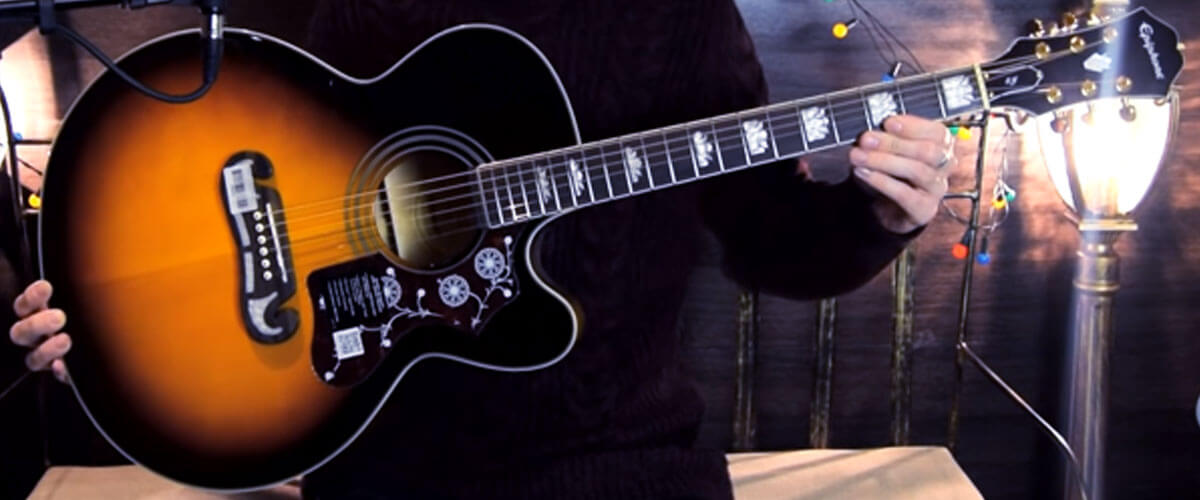
Of course, you can find flaws in the sound of any instrument, as it depends on many components and conditions. But as you can see, the materials for this guitar were chosen with the highest quality for its price segment. I think it sounds great - the sound is warm, balanced, deep, and resonant without buzzing or booming. It is so loud! You'll want to play it on stage, and the difference for acoustic sound in electronics is almost imperceptible, which is great.
Key specs
- Scale, in/cm: 25.5/64.7.
- Frets: 20.
- Fretboard radius, in/cm: 12/30.4.
- Type: acoustic/electric.
- Body material: maple.
- Neck material: maple.
- Neck joint: glued-in.
This Epiphone jumbo acoustic guitar pays tribute to the king of flattops – the classic Gibson SJ-200. Of course, you can find flaws in the sound of any instrument, but the materials for this guitar were chosen with the highest quality in its price segment. The sound is warm, balanced, deep, and resonant without buzzing or booming.
Epiphone DR-100
Many people know Epiphone was originally a budget branch of Gibson and therefore keeps the best traditions in manufacturing instruments but uses simpler and cheaper materials. In this Epiphone DR-100 review, I will tell you that even an inexpensive guitar can be a splendid companion to a musician. A complete instrument of quality build, the Epiphone DR-100 acoustic guitar has features worthy of you. Interested? Let's go!
Body
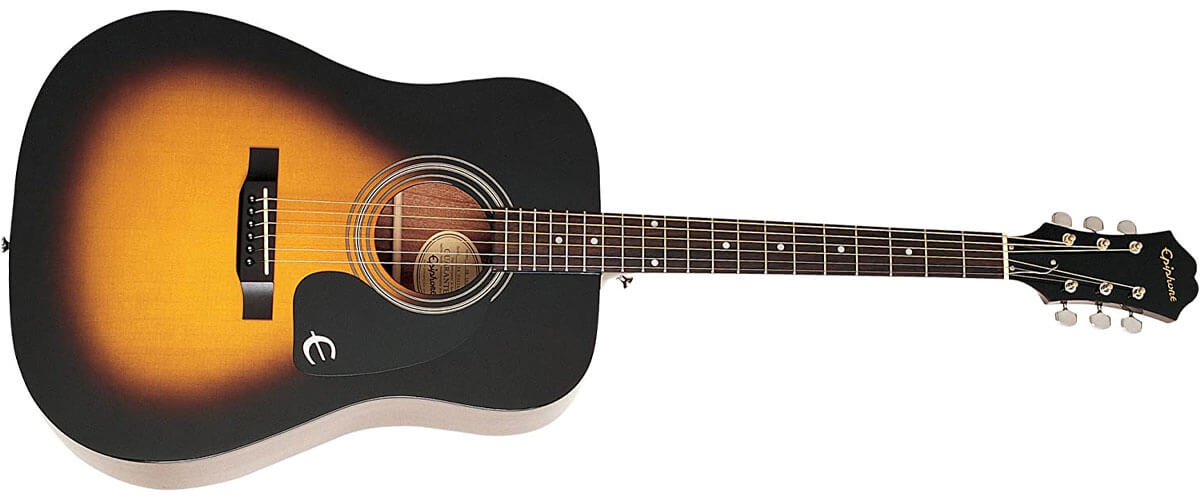
The classic Dreadnought shape with square shoulders always contributes to the voluminous, loud sound of the guitar. And let the top of the Epiphone DR-100 is not made of Solid Spruce, but of Laminated, so-called Selected Spruce with Gloss Nitrocellulose Lacquer coating, but the back and sides are made of Mahogany, so it sounds pretty good and stable, with pronounced mid-tones. Yes, maybe it lacks complex overtones, but the clarity of the sound can make up for it. This guitar is more for home, for the soul, than for the stage, but it can last you a long time, pleasing you day in and day out. Rounding out the cool design is the rosewood bridge and black fingerboard with the "E" logo.
Neck, fingerboard, headstock
The SlimTaper C-profile rosewood neck is glued to the body with a dovetail system for clarity and resonance and is quite sturdy in its own right. The guitar itself is not small at 8 pounds, and the scale is 25.5 inches long. So it probably won't be comfortable for kids. The fretboard is made of Okоumé (not Mahogany, as many people think, although their resonance properties are similar) and has 20 Medium Jumbo frets with dot inlays. This puts the fingerboard at your fingertips for almost any style of playing. The DR-100 head is a pre-1930s Gibson classic with nickel-plated hardware and "Epiphone premium" pickups. Basically, all the parts, including the tuners, are not of the highest quality, but they do exactly the job they are supposed to.
Sound quality

I conclude that the Epiphone DR-100 does very well for its segment. It holds notes for a long time and has a clean tone in a nice timbre. You may need to do some additional tuning, although initially, the guitar sounds very pleasant after unpacking. High frequencies, midrange - no outright audible flaws anywhere, but the low frequencies may be lacking. Use it carefully, take care of it, and it will repay you with mutual love.
Key specs
- Scale, in/cm: 25.5/64.7.
- Frets: 20.
- Fretboard radius, in/cm: 12/30.4.
- Type: acoustic.
- Body material: mahogany.
- Neck material: spruce.
- Neck joint: glued-in.
It is a good Epiphone acoustic guitar, which is very fine for its level: it holds notes for a long time and has a clear tone with a pleasant timbre. High frequencies, midrange – no outright audible flaws anywhere, but the low frequencies can be lacking. So use it carefully, take care of it, and it will repay you with mutual love.
FAQ
How to store guitars?
Where are Epiphone guitars made?
In 1986, three MBAs from Harvard bought Gibson/Epiphone and moved production to South Korea. For a long time, customers preferred guitars of this brand produced there, although there were production facilities in China and later in Indonesia.
In the 2000s, Epiphone turned to Japanese quality again, producing the “Elite Series” in Terada and FujiGen, using top-grade wood and hand finishing. That’s when the factory in Korea closed, but two new ones opened in Qingdao, China, where most models are made today, now with the new high quality.
It wasn’t until 2020 that Epiphone resumed operations in the US, beginning production of Texan guitars in Bosman, Montana.
How many frets are on an acoustic guitar?
Classical guitars and flamenco guitars usually have 19 frets, but in descriptions, you’ll often find “12-fret” or “14-fret,” which indicates which fret the neck is attached to the body of the guitar.
What is the difference between acoustic and classical guitar?
- A classical guitar has rounded shoulders, while an acoustic guitar is usually shaped like a Dreadnought. They are often larger than classical guitars, except for the Parlor, which, on the contrary, is smaller.
- A classical guitar’s fingerboard is often wider. And often classical guitars have no fret markings.
- Classic girth bridge is a sign of a classical guitar; the strings are knotted or have a ball tip. An acoustic guitar has a bridge with pins.
- The main difference is the use of nylon strings in a classical guitar. An acoustic guitar uses only steel strings.
You may consider other decent acoustic guitars:
Ibanez acoustic guitar reviews


